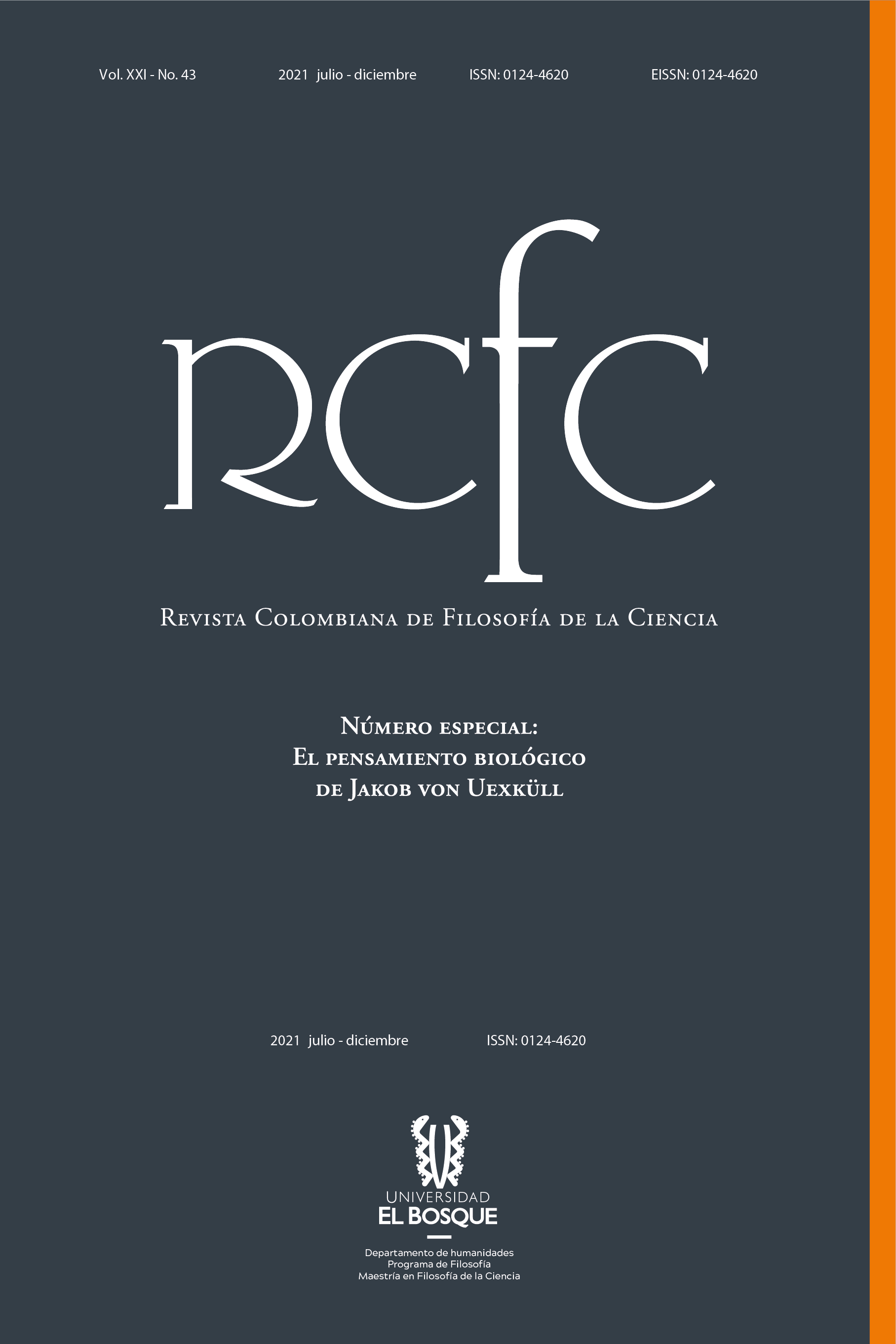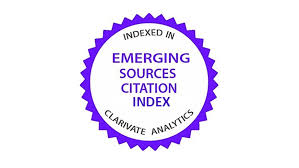Es natural la evolución sin selección
Una interpretación de los círculos funcionales utilizando como modelo el pulpo del coco (Amphioctopus marginatus)modelo el pulpo del coco (Amphioctopus marginatus).
DOI:
https://doi.org/10.18270/rcfc.v43i21.3463Palabras clave:
Círculo funcional, pulpo del coco, uso y manipulación de herramientas, evolución, significaciónResumen
El concepto de círculo funcional considera la existencia de una unidad dinámica e inseparable organismo-ambiente, en la que la autoorganización característica de los seres vivos les otorga a los organismos la capacidad de participar activamente en la creación de su entorno. Presento una interpretación evolutiva de este concepto utilizando el pulpo del coco (Amphioctopus marginatus), especie a la que se le atribuye la manipulación y el uso de herramientas. Introduzco algunos aspectos básicos de la biología de los pulpos, buscando abordar la manipulación de herramientas desde la experiencia, el juego y la significación. Esto representa una alternativa evolutiva desde y hacia la armonía y la congruencia entre el organismo y su ambiente, distante del azar, la lucha y la competencia intraespecífica impuestos por las teorías de adaptación/selección natural.
Descargas
Referencias bibliográficas
Aitken, Kenneth J. “Are Our Ideas About Octopus Life Too Anthropomorphic to Help?” Animal Sentience 4.26 (2019): online. <https://www.doi.org/10.51291/2377-7478.1490>
Albertin, Caroline B., et ál. “The Octopus Genome and the Evolution of Cephalopod Neural and Morphological Novelties”. Nature 525.7564 (2015): 220-224. <https://doi.org/10.1038/nature14668>
Andrade Pérez, Luis E. La ontogenia del pensamiento evolutivo. Bogotá. Universidad Nacional de Colombia, 2009.
Amodio, Piero, y Fiorito, Graziano. “Observational and Other Types of Learning in Octopus. Invertebrate Learning and memory” Handbook of Behavioral Neuroscience 22. Elsevier, 2013. 293-302. < https://www.doi.org/10.1016/B978-0-12-415823-8.00023-X>
Baluska, Frantisek, et ál. Eds. Communication in Plants: Neuronal Aspects of Plant Life. Heidelberg: Springer Science, 2006.
Baber, Christopher. Cognition and Tool Use. Forms of Engagement in Human and Animal Use of Tools. London: Taylor and Francis group, 2003.
Brentari, Carlo. Jakob von Uexküll: The Discovery of the Umwelt between Biosemiotics and Theoretical Biology. Dordrecht: Springer Netherlands, 2011. <https://www.doi.org/10.1007/978-94-017-9688-0>
Buchanan, Brett. Onto-ethologies: the animal environments of Uexküll, Heidegger, Merleau-Ponty, and Deleuze. United States of America: State University of New York, Alabany, 2008.
Burghardt, Gordon M. “Play”. Encyclopedia of animal behaviour. (2a. ed.). Ed. Jae Chun Choe. Londres: Academic Press, 2019. 109-114.
Emmeche, Claus., y Kull, Kalevi. Eds. Towards a Semiotic Biology: Life is the Action of Signs. London: Imperial College Press, 2011.
Favareau, Donald. Essential Readings in Biosemiotics: Anthology and Commentary. Dordrecht: Springer Science, 2010.
Finn Julian., Tregenza Tom., y Norman, Mark D. “Defensive tool use in a coconut-carrying octopus. Current Biology”. Current Biology. Elsevier, 19.23 (2009): <https://doi.org/10.1016/j.cub.2009.10.052>
Fiorito, Graziano y Scotto, Prieto “Observational Learning”. Octopus vulgaris Science 256.5056 (1922): 545–547. <https://www.doi.org/10.1126/science.256.5056.545>
Garvin, Philip. Piaget on Piaget, the epistemology of Jean Piaget. Yale University Media Design Studio, 1977. (Documental)
Godffrey-Smith, Peter. Otras mentes: El pulpo, el mar y los orígenes profundos de la consciencia. Barcelona: Taurus pensamiento, 2017.
Grasso, Frank y Basil, Jennifer. “The Evolution of Flexible Behavioural Repertoires in Cephalopod Molluscs”. Brain Behaviour and Evolution 74.3 (2009): 231-245. <https://doi.org/10.1159/000258669>
Hanlon, Roger., Vecchione, Mike., y Allcock, Louise. Octopus, Squid, and Cuttlefish: A Visual, Scientific Guide to the Oceans' Most Advanced Invertebrates. Chicago: The University of Chicago Press, 2018. <https://doi.org/10.7208/9780226459738>
Haraway, Donna J. Staying with the Trouble: Making Kin in the Chthulucene. Durham: Duke University Press, 2016.
Hoffmeyer, Jesper., y Stjernfelt, Frederik. “The Great Chain of Semiosis. Investigating the steps in the evolution of semiotic competence”. Biosemiotics 9.1 (2016): 7-29. <https://doi.org/10.1007/s12304-015-9247-y>
Huffard, Christine L. “Cephalopod Neurobiology: an Introduction for Biologists Working in other Model Systems”. Invertebrate Neuroscience 13.1 (2013): 11-18. <https://doi.org/10.1007/s10158-013-0147-z>
Jablonka, Eva y Marion J. Lamb. Evolution in four dimensions. The MIT Press, 2014.
Kant, Immanuel. Crítica del juicio. Barcelona: Editorial Espasa, 2013.
Kull, Kalevi. “Uexküll and the Post-Modern Evolutionism”. Sign Systems Studies 32.1 (2004): 99-114. <https://doi.org/10.12697/SSS.2004.32.1-2.04>
Kuba, M. Gutnick, T. Burghardt, M. “Learning from Play in Octopus”. Cephalopod Cognition. Cambridge University Press. Cambridge, 2014.
Lamarck, J.B. Filosofía zoológica 1809. Barcelona: Editorial Alta Fulla, 1986.
Lewontin, Richard C. The Triple Helix: Gene, Organism and Environment. London: Harvard University Press, 2000.
Lorenz, K. The Foundation of Ethology. Verlag- Nueva York: Springer Science, 1981.
Ledón, Rettig. Encyclopedia of animal Behaviour. Second edition Volume 2. Elsevier. London, 2019. Pp 13-19
Mather, Jennifer A., y Ludovic Dickel. “Cephalopod Complex Cognition”. Current Opinion in Behavioral Sciences 16.1 (2017): 131-137. <https://doi.org/10.1016/j.cobeha.2017.06.008>
Mejía Rendón, Joan Sebastián. “La agencia técnica animal: hacia una explicación de las conductas de uso y fabricación de herramientas”. Revista Colombiana de Filosofía de la Ciencia 19.38 (2019): 211-248. <https://doi.org/10.18270/rcfc.v19i38.2446>
Muñoz-rengel, Juan. “Los «apriorismos» kantianos bajo juicio cognitivo”. Revista de filosofía 21.1 (1999):143-168. <http://hdl.handle.net/11441/27398>
O’Brien, Caitlin., Ponte, Giovanna., y Graziano Fiorito. “Octopus”. Encyclopedia of Animal Behaviour (Second Edition). Ed. Jae Chun Choe. Academic Press, 2019. 142-148. <https://doi.org/10.1016/B978-0-12-809633-8.90074-8>
Odling-Smee, F John., Laland, Kevin N., y Feldman, Marcus W. Niche Construction: The Neglected Process in Evolution. Princeton: Princeton University Press, 2003.
Odling-Smee, John. “Niche-constructing Phenotypes”. The Role of Behaviour in Evolution. London: The MIT Press, 1988.
Oliveira da Silva, Gláucia. “Is natural selection a chimera? Reflections on the ‘survival’ of a principle”. Vibrant: Virtual Brazilian Anthropology 14.3 (2017): 1-21. <https://doi.org/10.1590/1809-43412017v14n3p001>
Oyama, S. et ál. Cycles of Contingency: Developmental Systems and Evolution. London: Massachusetts Institute of Technology, 2001. <https://doi.org/10.1162/106454602320184266>
Taborsky, M. “From Ethology to Behavioural Biology”. Encyclopedia of animal Behaviour. Second edition Volume 1. Elsevier. London, 2019.
Piaget, Jean. Play, Dreams and Imitation in Childhood. Londres: Routledge, 1999.
_______. Biology and Knowledge: An Essay on the Relations between Organic Regulations and Cognitive Processes. Chicago: The University of Chicago Press, 1971.
_______. Behaviour and Evolution. New York: Pantheon Books, 1978.
Popper, Karl. All Life is Problem Solving. New York: Routledge, 1999.
Schweid, Richard. Octopus. Animal Series. London. Reaktion books LTD, 2013.
Sreeja, Vijayamma y Bijukumar, Abi. “Ethological Studies of the Veined Octopus Amphioctopus Marginatus (Taki) (Cephalopoda: Octopodidae) in Captivity, Kerala, India”. Journal of Threatened Taxa 5.10 (2013): 4492-4497. <https://doi.org/10.11609/JoTT.o3256.4492-7>
Uexkull, Jakob. Theoretical Biology. New York: Harcourt, Brace & Company INC, 1926.
_______. Ideas para una concepción biológica del mundo. Trad. R. M. Terneiro. Colección Historia y filosofía de la ciencia. Buenos Aires: Espasa-Calpe, 1945. <http://hdl.handle.net/10637/3724>
_______. “A Stroll Through the Worlds of Animals and Men: A Picture Book of Invisible Worlds”. Instinctive Behavior: The Development of a Modern Concept. New York: International Universities Press Inc, 1957.
_______. “The New Concept of Umwelt: a Link between Science and the Humanities”. Semiotica 134.1 (2001): 111-123..
_______. Cartas biológicas a una dama. Prólogo Juan Manuel Heredia. Ciudad autónoma de Buenos Aires: Cáctus, 2016.
West-Eberhard, Mary J. “Phenotypic Accommodation: Adaptive Innovation Due to Developmental Plasticity”. Journal of Experimental Zoology 304B.6 (2005): 610-618. <https://doi.org/10.1002/jez.b.21071>
Vitti, Joseph. “Cephalopod Cognition in an Evolutionary Context: Implications for Ethology”. Biosemiotics 6.3 (2013): 393-401. <https://doi.org/10.1007/s12304-013-9175-7>
Descargas
Publicado
Cómo citar
Número
Sección
Licencia

Esta obra está bajo una licencia internacional Creative Commons Atribución-NoComercial-SinDerivadas 4.0.

| Estadísticas de artículo | |
|---|---|
| Vistas de resúmenes | |
| Vistas de PDF | |
| Descargas de PDF | |
| Vistas de HTML | |
| Otras vistas | |











